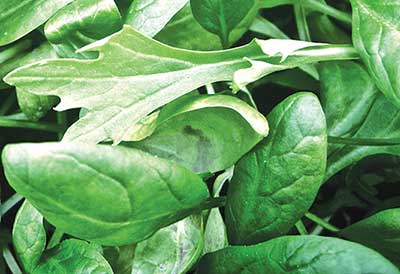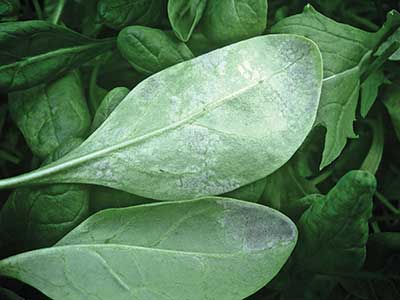 |
 |
| Downy mildew on winter spinach in a high tunnel. Photo by Eric Sideman |
By Caleb Goossen, Ph.D.
Winter-grown greens have increased dramatically in popularity, and subsequently in ubiquity, over the past couple of decades. We are miles beyond the era of my grandmother’s childhood in northern Vermont, where the “hungry period” set in during the end of winter and the beginning of spring, as the supply of stored food in the root cellar was emptying out, and the garden was not yet productive.
The increasing ubiquity of winter greens production may be creating its own sets of problems. Spinach downy mildew (Peronospora farinosa f.sp. spinaciae) is one such problem to watch for, although currently not omnipresent in the Northeast.
Downy mildew species are all within a class of fungus-like organisms called oomycetes (formerly known as water molds) that also includes some of our nastier plant pathogens, such as Phytophthora. Downy mildews are a disease primarily of foliage, causing harm by reducing the photosynthetic capacity of a plant, and making a greens crop unmarketable (and just plain unappetizing for the homestead grower). Spinach downy mildew is noticed first as yellowing patches on leaves, often bounded by leaf veins to create an angular leaf spot. As the disease continues to grow in the plant, it emerges through the stomata on the underside of leaves, producing characteristic fuzzy masses of purplish-gray sporangia that lend the “downy” descriptor to its name. These sporangia are produced overnight and therefore are most easily seen in the morning before they can disperse on air currents. Despite being a water mold, the sporangia of downy mildews require only high humidity to infect a plant.
Until relatively recently spinach downy mildew was a concern primarily in the American West and not in the Northeast. Before 2014 it hadn’t been reported in the Northeast for about 15 years. The disease likely appeared in our region from infected seed, or possibly infected plants that had been shipped in. It spreads predominantly via asexual airborne sporangia, which require a living spinach host (i.e., they don’t persist in soil). Because of this, year-round growing may create a bridge allowing spring greenhouse crops to infect the next season’s outdoor plantings. If two downy mildew mating types (analogous to sexes) are present on the same plant, sexual oospores can be produced as overwintering structures that can persist in the soil for up to three years. These could enable the disease to spread by seed, although researchers still don’t know if this is actually occurring.
Spinach downy mildew was first described in the United States in 1890. Only three identified races of the disease occurred before 1990, but many new races have emerged since then, overcoming the genetic resistance of some spinach varieties. Now 17 races exist, as do one or more currently unlabeled “novel” races. In recent outbreaks in New England, races 12, 14, 15 and a novel race were identified.
Management
Unfortunately, few good organic controls exist for downy mildews, so the best management approach is to avoid the disease and to limit its spread if it is found. All diseases need both a susceptible host and ideal environmental conditions to both infect and spread. As the name implies, spinach downy mildew infects only spinach; however, researchers haven’t definitively disproven that it could also infect closely related Chenopodium species such as lamb’s quarters.
Many modern spinach varieties have resistance to at least some downy mildew races bred into them, and seed suppliers typically display that resistance information. Although new races of downy mildew will likely continue to emerge, choosing a few varieties that resist one or more races known to have been present in the Northeast the past few years is advisable. Spinach downy mildew favors cool (59 to 70 F) and humid conditions, which are common in protected growing in late fall and early spring in the Northeast. As a result, best practices to reduce incidences of the disease include drip instead of overhead irrigation to reduce leaf wetness, generous plant spacing to promote good airflow, horizontal air flow fans angled toward the growing zone, and ventilating and removing row covers when weather conditions allow.
If Your Crop Is Infected
First, don’t panic! Although present in the Northeast, spinach downy mildew is still relatively rare here. Second, email a photo to me; I’m happy to help diagnose it, and if spinach downy mildew is found in our region, I would like to share incidences with Cornell University plant pathologist Meg McGrath to help in her efforts to better understand the current reappearance of the disease in our region. Dr. McGrath’s website Vegetable MD Online has some great resources, and she is working with her colleagues to identify and track the races and mating types present in outbreaks here to better understand their epidemiology. If you have spinach downy mildew confirmed, you may consider pre-emptively harvesting unaffected crop plants before infection sets in, destroying crop residues, and possibly rotating that soil out of spinach for at least three years.
About the author: Caleb is MOFGA’s organic crop and conservation specialist. You can contact him with your questions at [email protected].
